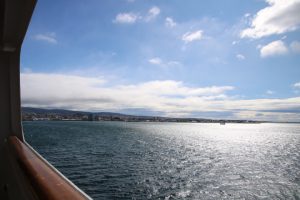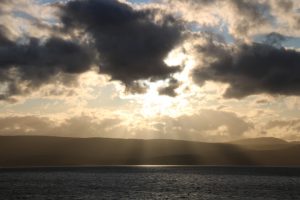We awoke at 07:00 in readiness for a voyage past the Chilean glaciers, however, there was a line of street lights, on the landward side of the ship and ships at anchor on the opposite side. This did not look like a place for glaciers!
A note under the door and an announcement from the Captain gave us the bad news that all is over and that work was in hand to repatriate us over the next few days. We are off Punta Arenas guarded by a Chilean naval vessel and when cleared we may be able to go to the harbour.
Overnight we had traversed part of the Beagle Channel. This is a 700 foot deep glacial gorge now flooded by the sea (fjord) running east west with many branches and bays before it narrows to enter the Pacific Ocean.
This can act as a wind funnel and it is recorded that Drake watched in awe as waves broke onto and over the 200 foot high cliffs. We remember Atlantic waves doing the same at the cliffs of Cape St. Vincent in Portugal because there was nothing to stop the waves and wind from the South Atlantic. We haven’t witnessed particularly high seas though this region is famous for them.
Wind is moving air within the atmosphere and at ground or sea level. The air in the atmosphere presses on every square inch of the earth by one pound weight (in old measurements). Solar radiation heats the earth in such a way that makes equatorial regions hot and polar regions cold. The hot air at the equator rises, cools, condenses and rains making the surface have less air pressure. At the same time colder air falls to the ground making the surface have more atmospheric pressure. The atmospheric systems attempt to maintain the average pressure so the air moves from where there is lots to where there is little. To put it simply, “winds do blow from high to low”. This is very simplistic because there are many highs and lows across the surface of the earth. Here in the sub-Antarctic there are few land masses near to the continent so the falling air making the high pressure blows out from the centre of the continent until the Antarctic convergence in the 50°s S where the winds build the massive waves. If the gradient between the high pressure and low pressure is steep then the stronger the wind.
As a wind’s speed increases so does its force, but at a rate equal to the square of the speed. So if the wind speed doubles the force quadruples. Additionally cold air is denser than warm air so making the force much more powerful. In the UK there are stronger gusts when the cold front passes in storms.
Also the greater the distance over which the wind blows (fetch) and the stronger the wind, hence the dangerous nature of “rounding the Horn” where the wind can circulate the earth.
All mariners after Magellan recognised the natural exaggeration of the state of the ocean here. The region in the 40°s S is known as the Roaring Forties and further south the Screaming Fifties.














